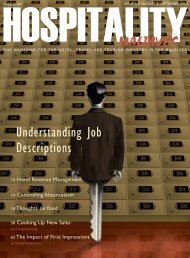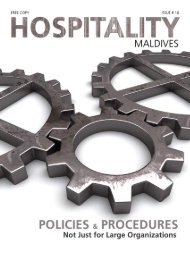Don't Let Your Systems Drive Your Customers Crazy! - Hospitality ...
Don't Let Your Systems Drive Your Customers Crazy! - Hospitality ...
Don't Let Your Systems Drive Your Customers Crazy! - Hospitality ...
You also want an ePaper? Increase the reach of your titles
YUMPU automatically turns print PDFs into web optimized ePapers that Google loves.
FINANCE & ACCOUNTING<br />
Paying The Right Price<br />
<strong>Your</strong> goal should be to pay the right price for prosperity. Determining<br />
that price for your operation goes beyond knowing what<br />
your expenses are. Reducing expenses to increase profit requires<br />
you to obtain the most efficient use of the expense dollar.<br />
Look, for example, at the payroll expense. Salesclerks are<br />
paid to sell goods, and their productivity is the key to reducing<br />
the payroll cost.<br />
If you train a salesclerk to make multiple sales at higher unit<br />
prices, you increase productivity and your profits without adding<br />
dollars to your payroll expenses. Or, if four salesclerks can be<br />
trained to sell the amount previously sold by seven, the payroll<br />
can be cut by three persons.<br />
An understanding of the worth of each expense item comes<br />
from experience and an analysis of records. Adequate records<br />
tell what has happened. Their analysis provide facts which can<br />
help you set realistic goals, you are paying the right price for your<br />
store’s prosperity.<br />
Analyze <strong>Your</strong> Expenses<br />
Sometimes you cannot cut an increase item. But you can get more<br />
from it and thus increase your profits. In analyzing your expenses,<br />
you should use percentages rather than actual dollar amounts.<br />
For example, if you increase sales and keep the dollar amount<br />
of an expense the same, you have decreased that expense as a<br />
percentage of sales. When you decrease your cost percentage, you<br />
increase your percentage of profit.<br />
On the other hand, if your sales volume remains the same,<br />
you can increase the percentage of profit by reducing a specific<br />
item of expense. <strong>Your</strong> goal, of course, is to do both: to decrease<br />
specific expenses and increase their productive worth at the same<br />
time.<br />
Before you can determine whether cutting expenses will increase<br />
profits, you need information about your operation. This<br />
information can be obtained only if you have an adequate recordkeeping<br />
system. Such records will provide the figures to prepare<br />
a profit and loss statement (preferably monthly for most retail<br />
businesses), a budget, break-even calculations, and evaluations of<br />
your operating ratios compared with those of similar types of<br />
business.<br />
Break-even<br />
A useful method for making expense comparisons is break-even<br />
analysis. Break-even is the point at which gross profit equals expenses.<br />
In a business year, it is the time at which your sales volume<br />
has become sufficient to enable your over-all operation to<br />
start showing a profit.<br />
Once your sales volume reached the break-even point, your<br />
fixed expenses are covered. Beyond the break-even point, every<br />
dollar of sales should earn you an equivalent additional profit<br />
percentage.<br />
It is important to remember that once sales pass the breakeven<br />
point, the fixed expenses percentage goes down as the sales<br />
volume goes up. Also the operating profit percentage increases at<br />
the same rate as the percentage rate for fixed expenses decreases<br />
- provided, of course, that variable expenses are kept in line.<br />
Locating Reducible Expenses<br />
<strong>Your</strong> profit and loss (or income) statement provides a summary<br />
of expense information and is the focal point in locating expenses<br />
that can be cut. Therefore, the information should be as current<br />
as possible. As a report of what has already been spent, a P<br />
and L statement alerts you to expense items that bear watching in<br />
the present business period. If you get a P and L statement only<br />
at the end of the year, you should consider having one prepared<br />
more often. At the end of each quarter might be often enough<br />
for some firms. Ideally, you can get the most recent information<br />
from a monthly P and L.<br />
Regardless of the frequency, for the most information two<br />
P and L statements should be prepared. One statement should<br />
report the sales, expenses, profits and/or loss of your operations<br />
cumulatively for the current business year to date. The other<br />
should report on the same items for the last complete month or<br />
quarter. Each of the statements should also carry the following<br />
information:<br />
1. this year’s figures and each item as a percentage of sales.<br />
2.<br />
3.<br />
4.<br />
5.<br />
6.<br />
7.<br />
last year’s figures and the percentages.<br />
the difference between last year and this year - over or under.<br />
budgeted figures and the respective percentages.<br />
the difference between this year and the budgeted figures -<br />
over and under.<br />
average percentages for your line of business (industry<br />
operating ratio) when available, and<br />
the difference between your annual percentages and the<br />
industry ratios - under or over.<br />
This information allows you to locate expense variation in<br />
three ways: (1) by comparing this year to last year, (2) by comparing<br />
expenses to your own budgeted figures, and (3) by comparing<br />
your percentages to the operating ratios for your line of business.<br />
The important basis for comparison is the percentage figure. It<br />
represents a common denominator for all three methods. When<br />
you have indicated the percentage variations, you should then<br />
study the dollar amounts to determine what line of operative action<br />
is needed.<br />
“…determine whether<br />
cutting expenses will increase<br />
profits,…”<br />
Because your cost cutting will come largely form variable expenses,<br />
you should make sure that they are flagged on your P and<br />
L statements. Variable expenses are those which fluctuate with<br />
the increase or decrease of sales volume. Some of them are: advertising,<br />
delivery, wrapping supplies, sales salaries, commissions,<br />
and payroll taxes. Fixed expenses are those which stay the same<br />
regardless of sales volume. Among them are: your salary, salaries<br />
for permanent non-selling employees (for example, the bookkeeper),<br />
depreciation, rent, and utilities.<br />
Taking Action<br />
When you have located a problem expense area, the next step<br />
obviously is to reduce that cost so as to increase your profit. A<br />
key to the effectiveness of your cost-cutting action is the worth<br />
of the various expenditures. As long as you know the worth of<br />
your expenditures, you can profit by making small improvements<br />
in expenses. Keep an open eye and an open mind. It is better to<br />
do a spot analysis once a month than to wait several months and<br />
then do a detailed study. Take action as soon as possible. You can<br />
refine your cost-cutting action as you go along.<br />
Reprinted with permission of www.youngentrepreneur.com<br />
HOSPITALITY MALDIVES OCTOBER/NOVEMBER 2006 25

















